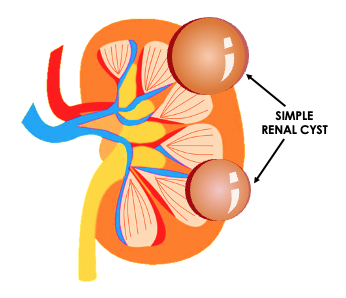[1]
Rediger C, Guerra LA, Keays MA, Wayne C, Reddy D, Ksara S, Leonard MP. Renal cyst evolution in childhood: a contemporary observational study. Journal of pediatric urology. 2019 Apr:15(2):188.e1-188.e6. doi: 10.1016/j.jpurol.2019.01.006. Epub 2019 Feb 1
[PubMed PMID: 30808538]
Level 2 (mid-level) evidence
[2]
Brownstein AJ, Bin Mahmood SU, Saeyeldin A, Velasquez Mejia C, Zafar MA, Li Y, Rizzo JA, Dahl NK, Erben Y, Ziganshin BA, Elefteriades JA. Simple renal cysts and bovine aortic arch: markers for aortic disease. Open heart. 2019:6(1):e000862. doi: 10.1136/openhrt-2018-000862. Epub 2019 Jan 28
[PubMed PMID: 30774963]
[3]
Sanna E, Loukogeorgakis S, Prior T, Derwig I, Paramasivam G, Choudhry M, Lees C. Fetal abdominal cysts: antenatal course and postnatal outcomes. Journal of perinatal medicine. 2019 May 27:47(4):418-421. doi: 10.1515/jpm-2018-0311. Epub
[PubMed PMID: 30763268]
[4]
Ferro F, Vezzali N, Comploj E, Pedron E, Di Serafino M, Esposito F, Pelliccia P, Rossi E, Zeccolini M, Vallone G. Pediatric cystic diseases of the kidney. Journal of ultrasound. 2019 Sep:22(3):381-393. doi: 10.1007/s40477-018-0347-9. Epub 2019 Jan 1
[PubMed PMID: 30600488]
[5]
Gimpel C, Avni EF, Breysem L, Burgmaier K, Caroli A, Cetiner M, Haffner D, Hartung EA, Franke D, König J, Liebau MC, Mekahli D, Ong ACM, Pape L, Titieni A, Torra R, Winyard PJD, Schaefer F. Imaging of Kidney Cysts and Cystic Kidney Diseases in Children: An International Working Group Consensus Statement. Radiology. 2019 Mar:290(3):769-782. doi: 10.1148/radiol.2018181243. Epub 2019 Jan 1
[PubMed PMID: 30599104]
Level 3 (low-level) evidence
[6]
Kennedy-Snodgrass C, Keenan V, Katz DS. Infected Renal Cyst as a Complication of Dropped Gallstones during Laparoscopic Cholecystectomy. Case reports in gastrointestinal medicine. 2018:2018():2478245. doi: 10.1155/2018/2478245. Epub 2018 Sep 30
[PubMed PMID: 30405920]
Level 3 (low-level) evidence
[7]
Nelson SM, Oettel DJ, Lisanti CJ, Schwope RB, Timpone VM. Incidental Renal Lesions on Lumbar Spine MRI: Who Needs Follow-Up? AJR. American journal of roentgenology. 2019 Jan:212(1):130-134. doi: 10.2214/AJR.18.20079. Epub 2018 Nov 7
[PubMed PMID: 30403526]
[8]
Eroglu FK, Kargın Çakıcı E, Can G, Güngör T, Yazılıtaş F, Kurt-Sukur ED, Celikkaya E, Üner Ç, Çakmakçı E, Bülbül M. Retrospective analysis of simple and stage II renal cysts: Pediatric nephrology point of view. Pediatrics international : official journal of the Japan Pediatric Society. 2018 Dec:60(12):1068-1072. doi: 10.1111/ped.13714. Epub
[PubMed PMID: 30320940]
Level 2 (mid-level) evidence
[9]
Li Y, Dai C, Bian T, Zhou J, Xiang Z, He M, Huang J, Zhu Y, Hu X, Jiang S, Guo J, Wang H. Development and prospective validation of a novel weighted quantitative scoring system aimed at predicting the pathological features of cystic renal masses. European radiology. 2019 Apr:29(4):1809-1819. doi: 10.1007/s00330-018-5722-6. Epub 2018 Oct 11
[PubMed PMID: 30311030]
Level 1 (high-level) evidence
[10]
Al-Otaibi K. Complications of 411 laparoscopic urological procedures: A single surgeon experience. Urology annals. 2018 Jul-Sep:10(3):308-312. doi: 10.4103/UA.UA_190_17. Epub
[PubMed PMID: 30089991]
[11]
Marte A, Pintozzi L. Laparoscopic treatment of symptomatic simple renal cysts in children: single-center experience. La Pediatria medica e chirurgica : Medical and surgical pediatrics. 2018 May 24:40(1):. doi: 10.4081/pmc.2018.168. Epub 2018 May 24
[PubMed PMID: 29871474]
[12]
Esposito C, Escolino M, Troncoso Solar B, Iacona R, Esposito R, Settimi A, Mushtaq I. Diagnosis and long-term outcome of renal cysts after laparoscopic partial nephrectomy in children. BJU international. 2017 May:119(5):761-766. doi: 10.1111/bju.13698. Epub 2016 Nov 14
[PubMed PMID: 27779799]

